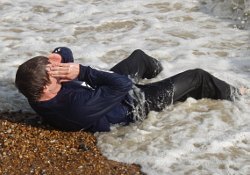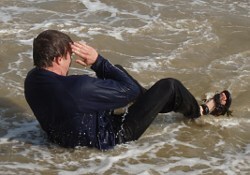Push-ups and Sit-ups
Poolside push-ups and sit-ups build overall strength. You may think you only work your arms dynamically, but your back and leg muscles have to hold you up statically.
Start building the muscles that you probably had no reason to use while lying around your house. The abdominal muscles used to hold the body rigid during the push-up are the rectus abdominis and the internal and external obliques. As the push-up involves multiple joints, it is a compound exercise.
The upper body muscles that come into play in the push-up are:
- the deltoids of the shoulders,
- the pectoral muscles of the chest,
- the triceps and biceps of the upper arm,
- the gluteal or hip muscles,
- and the erector spinae of the back.
In daily life, you often need to push against objects, from doors to shopping carts. The functional fitness you develop with push-ups provides the strength needed to perform these movements. Working the stabilizer muscles around the shoulders can help protect you from rotator cuff injuries.
Push-ups can be used as a measure of upper body fitness,
allowing you to assess whether you need to be doing more to keep your upper body in good working condition.
A 2019 study found that people who can do 40 push-ups
have fewer cardiovascular disease events than those who cannot complete 10 push-ups.
Avoid Common Mistakes
It is easy make errors with push-ups when you're tired or haven't built enough core strength. Look for these issues and switch to an easier variation if you can't maintain the best form.
Sagging in the Middle
A common mistake is sagging in the middle, caused by not properly bracing the core or keeping the torso stiff throughout the movement. Maybe start with push ups on your knees to keep your torso stable.
Improper Neck Alignment
Your neck should be in neutral alignment, the head in a straight line with the spine, eyes to the floor, and the top of your head pointed away from your feet. If you point your chin up or drop your head so much that you can see your toes, you are out of alignment.
Locked Elbows
Locking your elbows at the top of the movement is a mistake you might make as you fatigue and want a little rest. But this places too much stress on the joints and can lead to strain or injury. Always keep a slight bend in the elbows. If you are fatigued, it's time to take a rest before doing another set.
Hands Too Far Forward
If your hands are farther out from your body than your shoulders you are placing more strain on your shoulders. While you can vary how close your hands are together to get different effects, they should still be under your shoulders.
Limited Range of Motion
If you only go down partially with most of your push-ups, you aren't getting the full benefit. It is better to switch to an easier modification (such as knee or incline push-ups) that you can do with the full range of motion.
Shallow Water Push Ups
This is a good exercise to start your workout while you're still dry as it will gradually harder when your clothes slowly get wetter.
Do at least 10 push ups to get started. If this is a challenge, then you'd better start practicing right now. If you cannot do push-ups correctly or not enough of them, then start doing kneeling push-ups right now, start today. Exhale as you push up; inhale on the way back down before you contact the water.
In shallow water position yourself as shown. With your fingers pointing forward, place your hands below your shoulders. Keep hips and waist straight and your body in a straight line throughout. Keep legs together and use your toes as the pivot point. If this exercise is too difficult, pivot off your knees instead of toes by flexing knees.
Perform this motion in a continuous manner. Do as many repetitions as you can, without a time limit. Stop the exercise when the movement becomes forcibly strained.
Go Down
Facing downwards lower your body so your clothes just touch the water surface. Stay dry. Don't go all in yet. Hold this position for a moment.
Go Up
Push up by straightening your arms until your elbows are locked, then return to the starting position (with your chest just touching the water).
Full Immersion
Finally move into knee deep water.
Immerse yourself fully on the way down.
Then push your body up and out of the water,
which is quite a challenge when your wear lots of heavy wet clothes.
This is great fun, but rather exhausting.
Poolside Push-Ups
This push up exercise on the poolside can be inserted when swimming laps.
Come out of the pool and go onto the floor on all fours. Position your hands slightly wider than your shoulders.
Don't lock out the elbows but keep them slightly bent. Extend your legs back so you are balanced on your hands and toes, your feet hip-width apart.
Keep a tight core throughout the entire exercise and hold your body in a fairly straight line. Once in this position, here is how you will do a push-up:
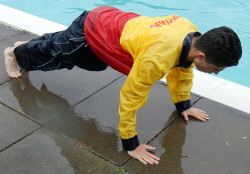
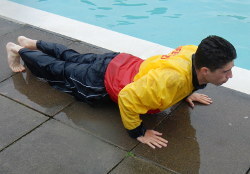
- Contract your abs and tighten your core by pulling your belly button toward your spine.
- Inhale as you slowly bend your elbows and lower yourself to the floor, until your elbows are at a 90-degree angle.
- Exhale while contracting your chest muscles and pushing back up through your hands, returning to the start position.
- After about 10-40 push ups go back into the pool and continue your swimming laps in the pool.
Hindu Push-up
The Hindu Push-up is a staple exercise in the training routines of Asian lifeguards. Many believe it originated in India.
It consists of a dynamic full body movement that will build strength and flexibility in your chest, shoulders, back, hips, and triceps. Another benefit when doing it in water is that it will prepare you for surf swimming. You get used to water washing over your head while you exercise.
Dive in head first
Get in position by standing with your feet slightly wider than shoulder width apart.
Take a deep breath and bend down and place your hands on the floor while keeping your arms and legs straight, with your head pointing down into the water.
Now make sort of a downward swooping motion with your body. Bring your body deeper under water by bending your elbows.
When your head gets close to the pool floor, continue moving your torso forward by arching your back. Lower your hips so they will now be near your hands and raise your head out of the water. Make sure to get a good stretch in your back.
Return to the starting position by doing the same swooping motion you made on the descent but in reverse.
This gives those muscles a bit more of a workout.
Deep Water Poolside Push-up
This is a great arm and upper body workout. As you get good with this, add more clothes to make it more challenging. Push-ups get tough in heavy kit. Try different hand positions, closer together or further apart.
Go into the pool. Facing the edge, put your hands on the poolside. Slowly raise yourself out of the water. Then go down and fully submerge. Repeat.
Next turn around, with your back towards the poolside, and push up that way.
You'll exercise a different set of muscles.
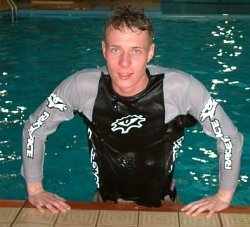
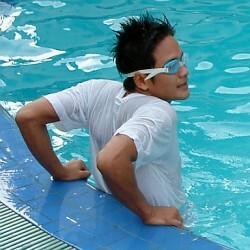
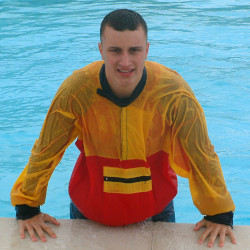
Water in your clothes adds weight.
Sit-ups in Shallow Water
Sit in knee deep water. Bend your knees at a 90-degree angle and put your feet flat on the floor. Get a friend to hold them down, if possible. Place your hands on the side of your head.
Lay down with your lower back against the floor and your head in the water to begin the movement, curl up and touch your elbows to your knees (count one), then return to the starting position.
Exhale as you come up; inhale when upright. Perform as many sit-ups as you can in 60 seconds.
Stop when the movement becomes forcibly strained or you feel nausea in your stomach. Relax briefly every time you lean back into the water.
Move to slightly deeper water so that your face gets fully submersed during each repetition.
This will prepare you for lifesaving in the sea, where waves wash over you.
Beach Workout
It gets a lot more intense when you run to the beach and do all of the above in the surf. Be aware that the waves will push you around and run over you. The surf will challenge you a lot more than the pool. You may want to combine with a 100 meter surf run between each push up or sit up session.
Push ups
Go down before a wave hits. Let it run over you and push up.
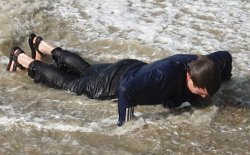
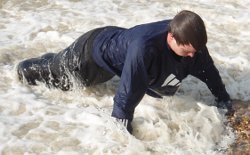
Sit ups
Same applies to sit ups. Lie down and let the wave roll over you. It may push you around if you sit up in its way.
